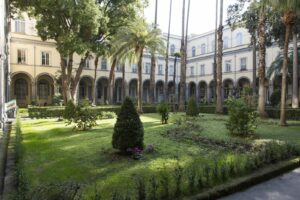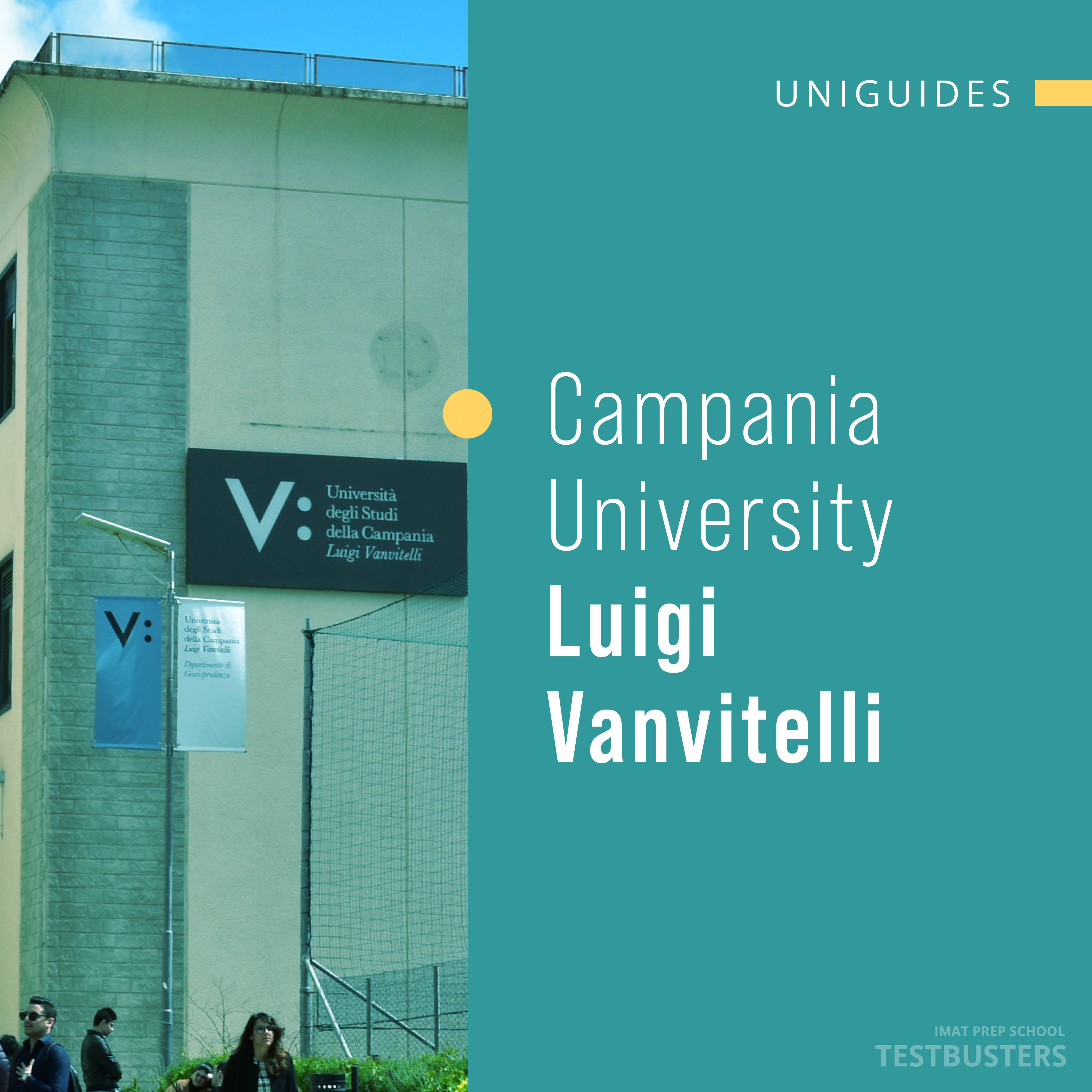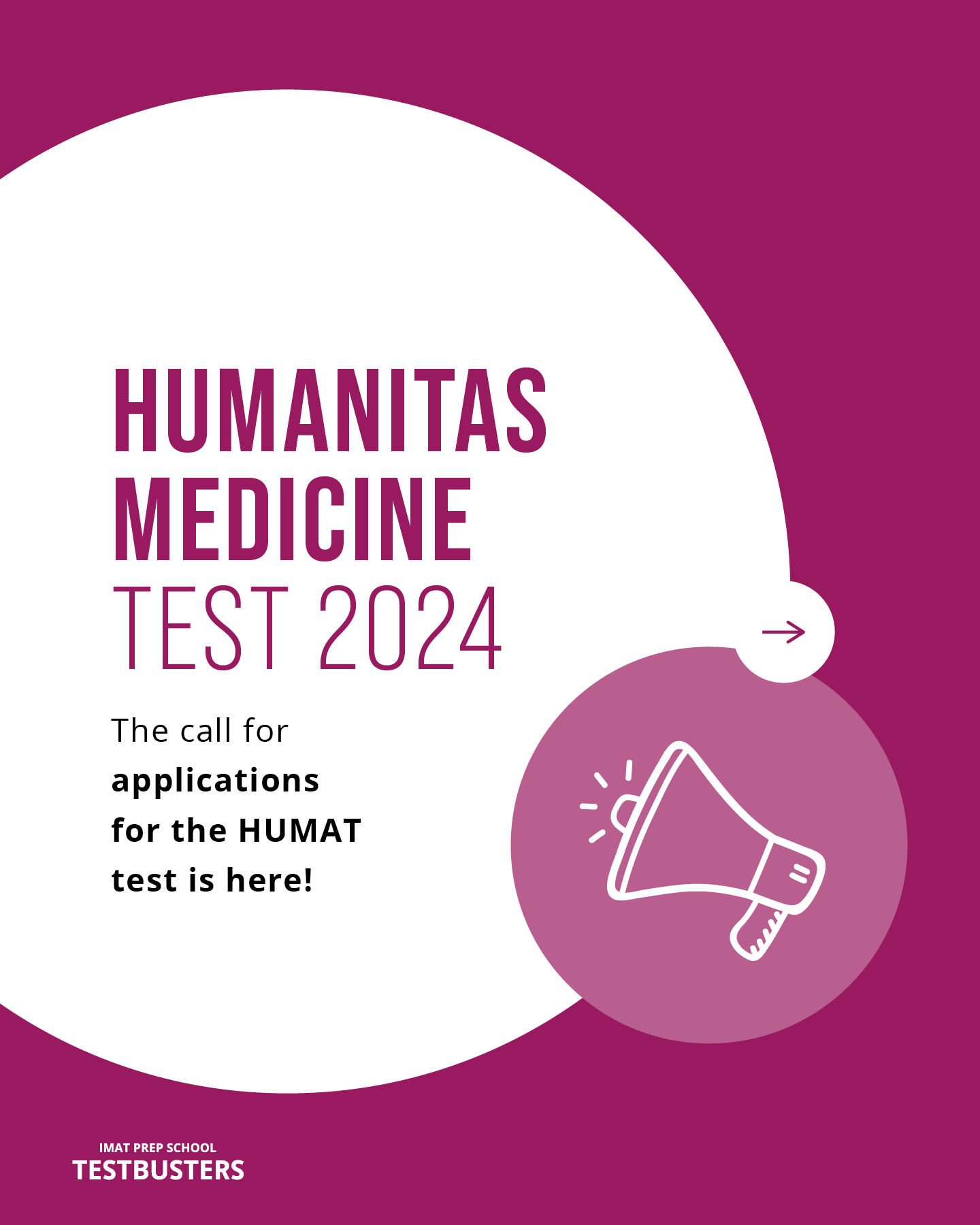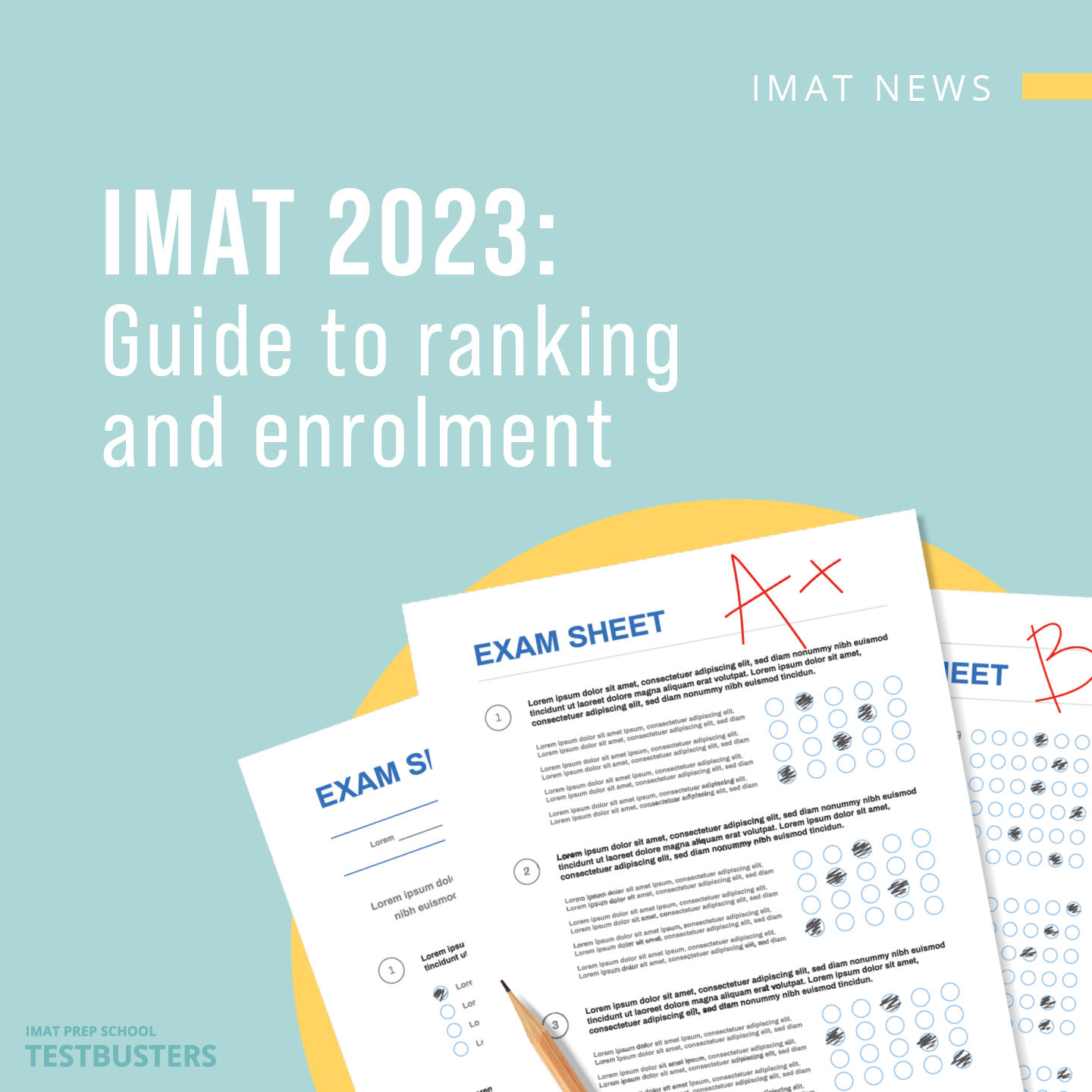The University of Campania “Luigi Vanvitelli” is relatively young, established in 1990 and, until 2016, it was named Second University of Naples – SUN.
The Faculty of Medicine has two locations:
- One in Naples (Napoli in Italian), where Medicine and Surgery in English is located;
- One in Caserta, which hosts the Italian course instead.
Medicine and Surgery
Ever since 2010/2011, Napoli Vanvitelli has also hosted a degree in Medicine and Surgery taught entirely in English. In the academic year 2022/2023, the course will hold 90 students:
- 50 for EU citizens and non-EU ones living in Italy;
- 40 for non-EU citizens resident abroad.
Please note that this number might also change in the following years.
Position
The primary Medicine and Surgery campus is located in the Sant’Andrea delle Dame complex in the center of Naples, close to the old Policlinico hospital. However, some lectures will be held in the Santa Patrizia complex, a few minutes from the main venue.
Located in the city center of Naples, the campus is easy to reach with line 1 of the metro and getting off at the stop named “Museo” but also by line 2, getting off at the stop “Cavour.” From both of these, you are roughly five minutes on foot away from the Sant’Andrea dalle Dame campus.
The main hospital where students can do clerkships is the new Policlinico hospital, where students can attend from the second semester of the third year.
If you’re looking for accommodations in Naples, we recommend looking for houses anywhere along the metro line 1; usually, students search for apartments in the “Vomero Alto” area, but any stop will do.

Teaching plan
The teaching plan is divided into preclinical and clinical years: the first two comprise the former, which focuses on basic subjects necessary to learn and study medicine at 360 degrees. From the third year on, clerkship will start, officially beginning the clinical part of your degree.
A crucial characteristic of this course’s teaching plan is that students are able to pull their weight and make their own choices. For example, students with an exceptionally high average can apply for the PhD program, which will help them focus better on specific aspects of their careers.
There are also many initiatives, namely Elective Didactic Activity (ADE), AFP and tutoring services provided either directly by the professors or peers.
ADEs start right from the first year: the main course you will undergo will be “How to present a scientific article” for the histology and embryology course, but also one for the chemistry course named “Chemical properties of dietary bioactive compound.”
Moreover, an Italian Language course for international students is strongly suggested they follow: from the third year onwards, the clerkship and the clinical training start: this means that all students must understand Italian to communicate with doctors and patients.
The professionalizing educational activities (AFP) provide future doctors with the professional skills essential for pursuing post-graduate activities. AFPs are a form of tutorial teaching carried out under the direct supervision of a teacher-tutor and imply a training simulation at a professional level with a considerable degree of autonomy.
In the first year, you will only find the “Methodological Bases in Medicine and Bioethics” course. Still, from the third year, they will focus more on the different clinical subjects (internal medicine, general surgery, pediatrics, obstetrics and gynecology).
The tutoring service, instead, is organized for almost all topics: in the first year, the physics and chemistry tutoring is arranged directly by professors, while for the anatomy one, upper-year pupils tutor you.
One requirement to enter the clinical years is successfully passing the second-year Human Anatomy exam. Unfortunately, you cannot enroll in the third year unless you overcome this exam.
Attendance is mandatory at 75% and it’s strictly controlled. Students sign an attendance sheet at the beginning of the lecture or, more recently, swipe the university badge when they come in.
The first year
Lessons for the first year usually start around the half of November but will begin the first days of October for the following years. In the first year, you will have a total of 7 exams.
First semester
- Biology, Molecular Biology and General Genetics (12 CFU): the exam is divided into three parts: a written in genetics (60 multiple choice questions and 5 open questions) can only be taken once, then you move on to the oral of the two biologies. However, if you prefer, you can skip the genetics written and do all three subjects orally. The written exam is considered when you go to the oral, and the total mark is the average of all three parts.
- Chemistry (6 CFU): it’s a written exam with theory and exercises (organic and inorganic chemistry, nomenclature, mechanisms of reactions) plus a few multiple-choice questions.
- Physics Applied to Medical Science (4 CFU): This exam deals with physics applied to medicine: for example, when you study waves, you also focus on ultrasound and MRI machines. It’s a written exam with 6 exercises plus three theory questions on theory and medical applications (like radiology machines).
Second semester
- Human Anatomy 1 (9 CFU): It does not include an exam in the first year; however, from this year, students can give part of the exam in September. This is because the complete exam will be held in the first semester of the second year, with Human Anatomy II. The exam is written, the slide examination at the microscope and the oral part.
- Medical Histology and Embryology (9 CFU): It comprises a written and oral examination that must be taken on the same day; however, the written remains valid if you don’t pass the oral.
- Scientific English (2 CFU): it’s a pass-or-fail examination with no vote focusing on the knowledge of English medical terminology.
- Methodological Bases in Medicine and Bioethics (7 CFU): it’s a brand-new pass-or-fail exam that gives insights into the hospital world and life as a doctor. Starting this year, a practical part done in the hospital is present so that students can directly approach the hospital (practical part).
- ADE (1 CFU): named “how to present a scientific article,” in which students must have group presentations on different medical papers for the histology and embryology class.
The schedule can vary: lectures are held mainly in the afternoon for the first semester from 2.00 to 7.00 p.m. During the second one instead, almost all lessons are held in the morning from 8.30 a.m. to 2 p.m.
For further information, the timetable for all years is available here.
Pros and cons of Medicine and Surgery
Pros
- Other than the standard exam sessions, there are also extraordinary appelli almost every month (specifically in March, April, October and December) to facilitate students who couldn’t give one exam in time.
- Being only a few students, there is much more interaction with fellow and older peers, creating a familiar and comfy environment.
- There are many suitable structures, study halls and attractive student services provided by the University
- The secretary’s office is placed directly inside Sant’Andrea dalle Dame, and it’s incredibly efficient in case of issues or organizational problems, without booking an appointment, waiting excessively, or going to the other side of town.
- There is a high rate of exam recognition if students have attended another university and don’t want to take the same exam twice.
- The English degree is equivalent to the Italian one; they are equally recognized in Italy and the EU. For non-EU countries, it is necessary to check individual regulations. After graduation, you can register for the Postgraduate test in Italy.
- All pupils are exceptionally welcoming, inclusive and ready to answer questions; moreover, the university students list is active and organizes many exciting initiatives.
- The University is in the city center: therefore, you are immersed in the Neapolitan environment and many facilities are close to the main building.
Cons
- Study rooms are only open until 7 p.m., so staying longer is impossible.
- Despite being highly qualified and fluent, professors are still Italian. Consequently, their pronunciation is not always perfect, and their English is not that British.
- The University and the hospital are in different parts of the city (around 4-5 metro stops away from one another): therefore, it can take a bit to reach the two locations.
- Medical terminology in Italian and English is similar but not identical: this implies that once in the ward during clerkships, it’s vital to learn also the medical expressions in Italian to communicate better with patients and doctors.
Lunch and libraries
The main campus does not have a canteen but does provide vouchers to request one meal per day for Adisurc scholarships winner at a few locations near the university. Moreover, the University is located in the city center, famous for housing the historic pizzerias of the Neapolitan capital, such as the world-known “Sorbillo” pizzeria.
Around the university are several bars and restaurants for every palate: poké, sushi, pasta, pizza and small grocery stores, usually around Piazza Dante.
If you feel like eating a home-cooked meal, you can bring your packed lunch and heat it in one of the different microwaves around campus.
One of the main characteristics of the Sant’Andrea complex is that there are many different study halls where you can meet up with friends, open from 7 a.m. to 7 p.m. The Medical Library is also open until 4 p.m. which holds specific books for Medicine.
In the Santa Patrizia complex are the microscopic anatomy laboratories, an auditorium and, most importantly, the anatomical museum (MUSA), which gathers special collections of anatomical preparations and a dentistry collection.
Lastly, suppose you need a quiet place to study that is not inside the University. In that case, students from all faculties usually attend the “Biblioteca Nazionale di Napoli Vittorio Emanuele III” in Piazza del Plebiscito, 1. However, there are other alternatives, such as municipal libraries.
Studying abroad
Vanvitelli University allows enrolled students to participate in the Erasmus+ program, an EU-sponsored mobility program that will enable you to spend three to 12 months at a European university. It allows you to attend courses, take exams and get recognition. The best time to participate in such an experience is around the fourth year and the most popular locations for Medicine students are France, Spain, Portugal, Austria and Turkey.
Moreover, they can also choose the Erasmus+ Traineeship Project, the chance to do a training internship abroad at companies, research and training centers, or other organizations.
For more information: Study Abroad.
Bureaucracy and secretary’s office
Main office:
- Address:
Via Luciano Armanni, 5 – 80138 – Naples
- Phone:
+ 39 081 18760 311 / 315 / 316 / 317 / 318 / 319 / 320 / 321
- Email:
- Hours:
Monday and Wednesday from 1.30 p.m. to 3.30 p.m.;
Tuesday, Thursday and Friday from 9.00 a.m. to 12.00 a.m.
Medicine and Surgery Office:
- Address:
- Andrea delle Dame – Via L. De Crecchio, 7 – 80138 Naples
- Phone:
+39 081 5667240
- Email:
- Hours:
Monday and Wednesday from 1.30 p.m. to 3.30 p.m.;
Tuesday, Thursday and Friday from 9.00 a.m. to 12.00 a.m.
Enrollment
You can enroll in the Medicine and Surgery course right after you are assigned according to the ranking list. Students must download, fill and scan in PDF format the Enrollment Form signed in all the parts, also adding a passport-size picture and their Passport or ID. After paying the first tax installments, you must send all the receipts and documents to [email protected] to complete the procedure. You can check out the detailed instructions at this link for more information.
You also need to register in order to enter your personal area, which gives access to the institutional email, wifi or scholarships. It explains how to use the University app, called “myvanvitelli app,” where students can pay fees, book exams and see all the grades with the total average, all at their fingertips.
Transferring
Only students who have sat the competitive entrance exams for admission to the Medicine and Surgery Degree Programme at the University and are ranked in a position making them eligible for admission are allowed to transfer to the program. Students admissible to the sixth year with outstanding modules cannot transfer.
Moreover, transfers are only accepted depending on the number of available places each year, the number of credits (CFU) acquired each year and the course regulations.
After transferring, students may apply for an exam recognition request, asking for the credits they have obtained in their previous program of study to be recognized. Exams may be recognized after being deemed compatible with the number of credits and learning objectives of teaching in the Degree Programme System of the Medicine and Surgery Degree Programme upon the decision of the Medicine and Surgery Degree Programme Committee.
Exams may be totally or partially transferred. In the latter case, students must sit any partially transferred exams transcribed only in the student’s academic record. Transferred exams receive the same mark; the average mark will be calculated for more than one transferrable exam.
For more information: Transfers.
Scholarships
Vanvitelli University provides qualifying students with financial support throughout their careers. Students of any course can apply for scholarships if they meet one or more of the following criteria:
- Financial Need;
- Merit;
- Exceptional Talent;
- Students belonging to households with two or more family members enrolled.
For more information: Study grants.
Moreover, ADiSURC, the regional agency dealing with the right to study in Campania, gives other scholarships mainly based on the family’s financial status or ISEE. It also provides vouchers for meals and accommodations in University residences.
Accommodations
The University of Campania “Luigi Vanvitelli” is a partner of Housing Anywhere, an international platform of rental services from student to student. Incoming students from abroad in Naples and Caserta can find and book a room; however, the service is known to have some issues with booking.
Therefore, there is an alternative, named NaResidenza, for international students. It’s located in the city center. It has many different types of rooms, from triple to single, and highly reasonable prices characterize it.
For more information: services for foreign students.
Conclusion
In conclusion, living in Naples means living in one of the most beautiful cities in the world: it’s rich in history, art, monuments and beaches, which make it unique in the Italian panorama. We promise you will leave a part of your heart here, whether you’ll be living or just passing by!
Discover other Italian universities.



